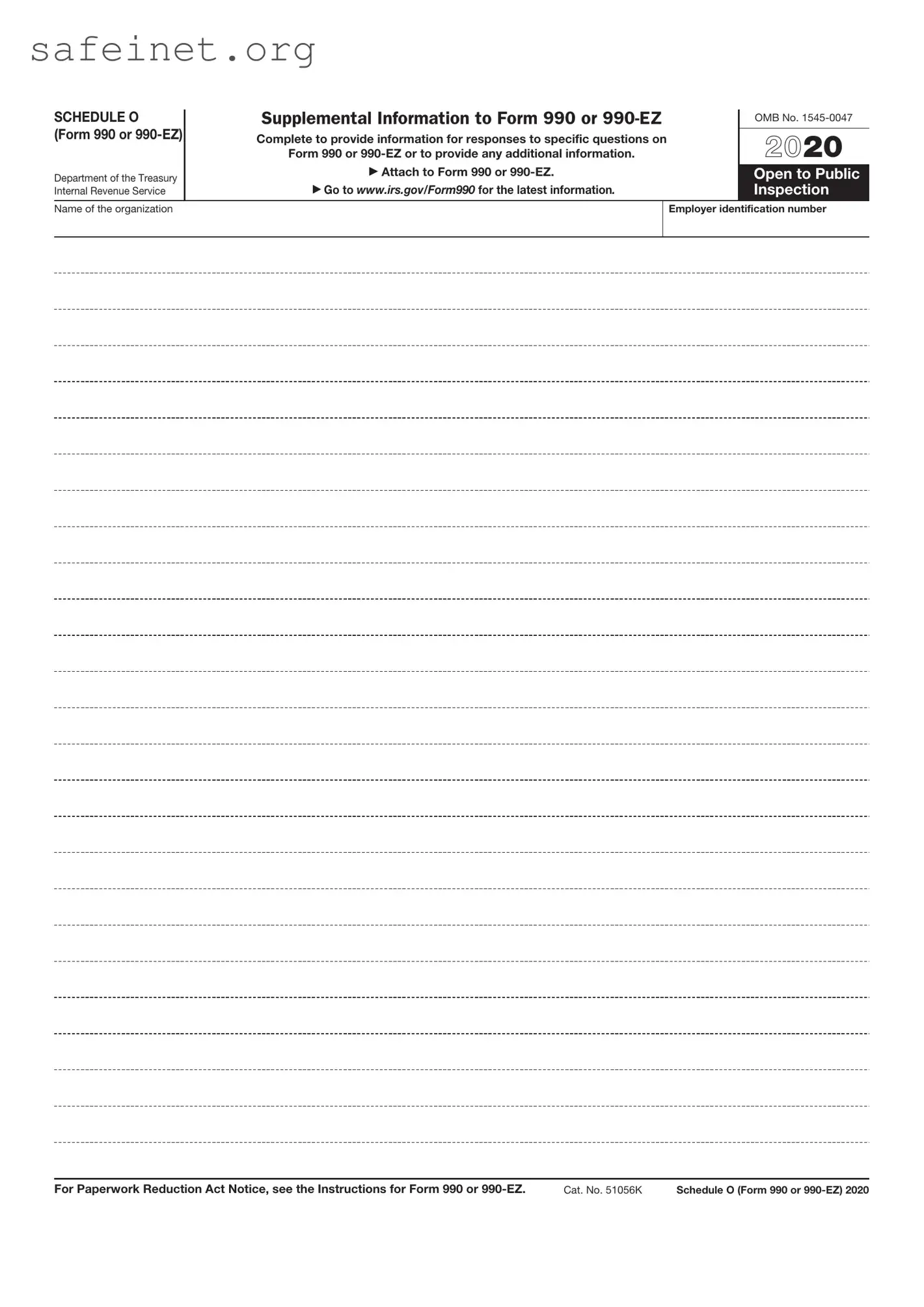General Instructions
Section references are to the Internal Revenue Code unless otherwise noted.
Future developments. For the latest information about developments related to Schedule O (Form 990 or 990-EZ), such as legislation enacted after the schedule and its instructions were published, go to www.irs.gov/Form990.
Purpose of Schedule
An organization should use Schedule O (Form 990 or 990-EZ), rather than separate attachments, to provide the IRS with narrative information required for responses to specific questions on Form 990 or 990-EZ, and to explain the organization’s operations or responses to various questions. It allows organizations to supplement information reported on Form 990 or 990-EZ.
Don’t use Schedule O to supplement responses to questions in other schedules of the Form 990 or 990-EZ. Each of the other schedules includes a separate part for supplemental information.
Who Must File
All organizations that file Form 990 and certain organizations that file Form 990-EZ must file Schedule O (Form 990 or 990-EZ). At a minimum, the schedule must be used to answer Form 990, Part VI, lines 11b and
19.If an organization isn’t required to file Form 990 or 990-EZ but chooses to do so, it must file a complete return and provide all of the information requested, including the required schedules.
Specific Instructions
Use as many continuation sheets of Schedule O (Form 990 or 990-EZ) as needed.
Complete the required information on the appropriate line of Form 990 or 990-EZ prior to using Schedule O (Form 990 or 990-EZ).
Identify clearly the specific part and line(s) of Form 990 or 990-EZ to which each response relates. Follow the part and line sequence of Form 990 or 990-EZ.
Late return. If the return isn’t filed by the due date (including any extension granted), attach a separate statement giving the reasons for not filing on time. Don’t use this schedule to provide the late-filing statement.
Amended return. If the organization checked the Amended return box on Form 990, Heading, item B, or Form 990-EZ, Heading, item B, use Schedule O (Form
990 or 990-EZ) to list each part or schedule and line item of the Form 990 or 990-EZ that was amended.
Group return. If the organization answered “Yes” to Form 990, line H(a), but “No” to line H(b), use a separate
attachment to list the name, address, and EIN of each affiliated organization included in the group return. Don’t use this schedule. See the instructions for Form 990, I. Group Return.
Form 990, Parts III, V, VI, VII, IX, XI, and XII. Use Schedule O (Form 990 or 990-EZ) to provide any narrative information required for the following questions in the Form 990.
1.Part III, Statement of Program Service Accomplishments.
a.“Yes” response to line 2.
b.“Yes” response to line 3.
c.Other program services on line 4d.
2.Part V, Statements Regarding Other IRS Filings and Tax Compliance.
a.“No” response to line 3b.
b.“Yes” or “No” response to line 13a.
c.“No” response to line 14b.
3.Part VI, Governance, Management, and Disclosure.
a.Material differences in voting rights among members of the governing body in line 1a.
b.Delegation of governing board’s authority to executive committee in line 1a.
c.“Yes” responses to lines 2 through
7b.
d.“No” responses to lines 8a, 8b, and
10b.
e.“Yes” response to line 9.
f.Description of process for review of Form 990, if any, in response to line 11b.
g.“Yes” response to line 12c.
h.Description of process for determining compensation, in response to lines 15a and 15b.
i.If applicable, in response to line 18, an explanation as to why the organization checked the Other box or didn’t make any of Forms 1023, 1024, 1024-A, 990, or 990-T publicly available.
j.Description of public disclosure of documents, in response to line 19.
4.Part VII, Compensation of Officers, Directors, Trustees, Key Employees, Highest Compensated Employees, and Independent Contractors.
a.Explain if reporting of compensation paid by a related organization is provided only for the period during which the related organization was related, not the entire calendar year ending with or within the tax year, and state the period during which the related organization was related.
b.Description of reasonable efforts undertaken to obtain information on compensation paid by related organizations, if the organization is unable to obtain such information to report in column (E).
5.Explanation for Part IX, Statement of Functional Expenses, line 11g (other fees
for services), including the type and amount of each expense included in line 11g, if the amount in Part IX, line 11g, exceeds 10% of the amount in Part IX, line 25 (total functional expenses).
6.Explanation for Part IX, Statement of Functional Expenses, line 24e (all other expenses), including the type and amount of each expense included in line 24e, if the amount on line 24e exceeds 10% of the amount in Part IX, line 25 (total functional expenses).
7.Part XI, Reconciliation of Net Assets. Explain any other changes in net assets or fund balances reported on line 9.
8.Part XII, Financial Statements and Reporting.
a.Change in accounting method or description of other accounting method used on line 1.
b.Change in committee oversight review from prior year on line 2c.
c.“No” response to line 3b.
Form 990-EZ, Parts I, II, III, and V. Use Schedule O (Form 990 or 990-EZ) to provide any narrative information required for the following questions.
1.Part I, Revenue, Expenses, and Changes in Net Assets or Fund Balances.
a.Description of other revenue, in response to line 8.
b.List of grants and similar amounts paid, in response to line 10.
c.Description of other expenses, in response to line 16.
d.Explanation of other changes in net assets or fund balances, in response to line 20.
2.Part II, Balance Sheets.
a.Description of other assets, in response to line 24.
b.Description of total liabilities, in response to line 26.
3.Description of other program services, in response to Part III, Statement of Program Service Accomplishments, line 31.
4.Part V, Other Information.
a.“Yes” response to line 33.
b.“Yes” response to line 34.
c.Explanation of why organization didn’t report unrelated business gross income of $1,000 or more to the IRS on Form 990-T, in response to line 35b.
d.“No” response to line 44d.
Other. Use Schedule O (Form 990 or
990-EZ) to provide narrative explanations and descriptions in response to other specific questions. The narrative provided should refer and relate to a particular line and response on the form.
Don’t include on Schedule O F! (Form 990 or 990-EZ) any social
security number(s), because this CAUTION schedule will be made available for public inspection.


